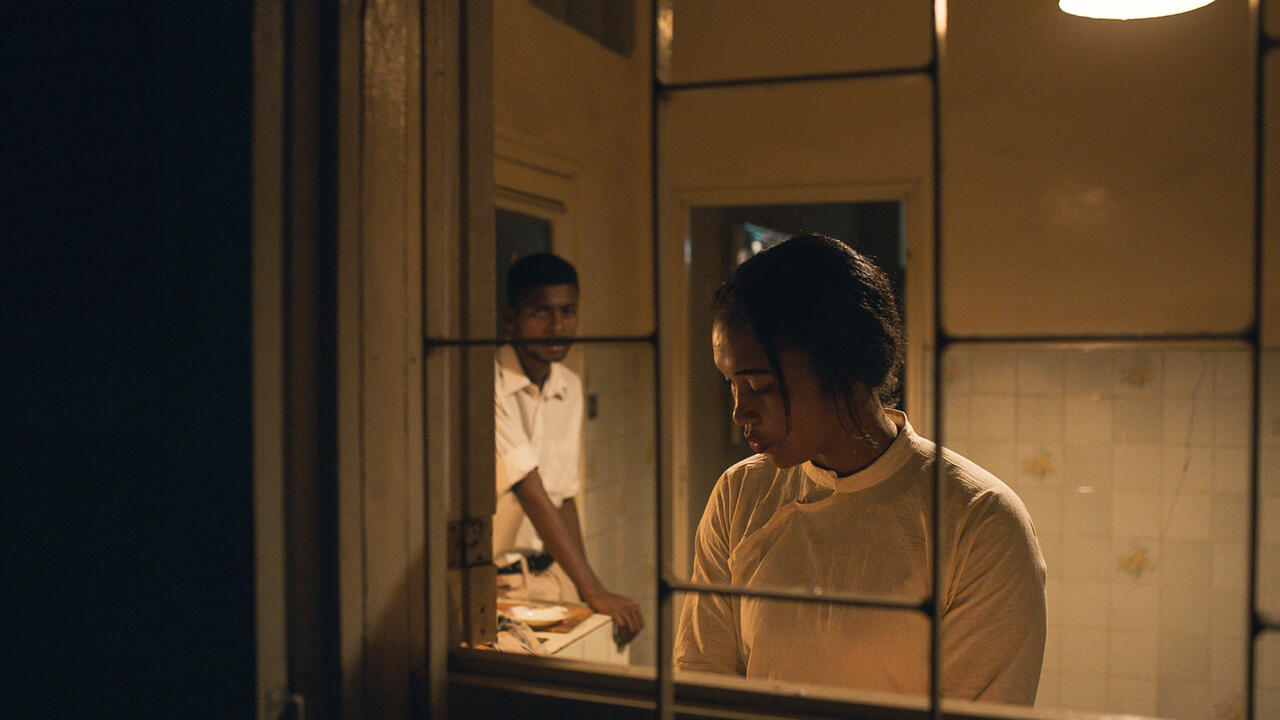A.K. Burns
Callicoon Fine Arts and New Museum, New York, USA
Callicoon Fine Arts and New Museum, New York, USA

I do a double-take every time I see the lights on at 190 Bowery. Like a dealer or a sex worker, a sneering junkie or a drunk, the grimy Germania Bank building surveys the rapidly gentrifying lower Manhattan neighbourhood, curmudgeonly memorializing its sordid history. It was quickly converted into luxury office space last year, though they’re still washing the graffiti from its walls. The lights went on again, but everyone in it had already scattered.
A.K. Burns’s exhibition, ‘Shabby but Thriving’, similarly personifies the spirit of 231 Bowery, the adjacent property to the New Museum, which the institution purchased in 2008 and is set to open as a new wing next year. The exhibition’s centrepiece, Burns’s two-channel, five-part video Living Room (2017–ongoing), explores the emptied apartment building’s confines, admitting viewers into a squatter’s paradise. In the first act, ‘Dwarf Planets (Celestial Bodies)’, three teenagers lounge on sofas that slowly rotate on castors, while plucking sweets out of bags of topsoil and reading excerpts from Principia Discordia, a cult 1963 text written by Greg Hill and Kerry Wendell Thornley that outlines religious contrarianism, whose ironic mysticism can be summed up with the phrase: ‘Reality is the original Rorschach.’ Burns draws from science fiction and myth: in ‘Animalia Anima’, the kids communicate with animals and flop around like fishes. As with writers Ursula K. Le Guin or Samuel R. Delany, Burns embeds us in an alternate reality that challenges our assumptions about human nature, though her brand of storytelling is more provisional and flat-footed. There’s a kitschy charm when the children clumsily disembowel the sofas with iridescent novelty knives.
Burns attributes body parts to each section of the building (the bathrooms, for example, are kidneys), framing them as metabolic environments. In a separate act, ‘Detox Tub Talks’, a medical patient covered in bandages and a naked, bathing lady collaging wet newspaper onto the bathroom’s tiled walls challenge the semantic seriousness of critical language about bodies. Over a slice of chocolate cake, they discuss the value of ideological discourse to the systematically oppressed, before comically trying to name the most legendary lesbian dance party. Though the film has its cringe-worthy moments, it reinforces a sincere chemistry between the characters and their subject-positions.
Living Room culminates in the building’s basement or ‘uterus’, where dancers of different races and genders convene the final act: ‘The Movement’. ‘HER’, ‘NO’, ‘OR BUST’, their custom T-shirts declare – not just echoing Hillary Clinton’s presidential campaign cries, but proposing a social model based on radical, intersectional female power. The video is projected between an unfinished partition and a piece of leaning drywall, while the exhibition space re-creates the interiors of 231 Bowery along with a denuded sofa frame, blue LEDs, bags of soil, grimy carpet and a series of sculptures made from Cheestrings.
Burns’s concurrent exhibition at Callicoon Fine Arts, ‘Fault Lines’, takes aim at the political partitioning of public space. A series of metal fences in the window gives the effect of gallery-goers being penned in like sheep. The steel bars are angled to spell out the permutations of former US Secretary of Defense Donald Rumsfeld’s declaration that there are ‘known knowns’ (the predecessor of ‘alternative facts’). Inside the gallery, clotted newspaper collages Post Times (Weather Report) and Post Times (National Friday) (both 2017) recall the media’s role in shaping the minds of the voting public.
In Hand Out (She Was Warned) (2017), a concrete hand displays a gold IUD contraceptive pendant and chain as though it is a luxury item.
Studio space offers brief sanctuary from these risks but, on Bowery, it is astronomically unaffordable. By emphasizing the precarious and temporary conditions in which she completed her residency, Burns highlights art’s role as aegis: a combative shield responsive to the needs of its community. In case everything feels lost already, Burns has also installed a punching bag in the New Museum’s reading room.
Main image: A.K. Burns, Living Room, 2017-ongoing, production still. Courtesy: the artist and Callicoon Fine Arts and New Museum, New York























